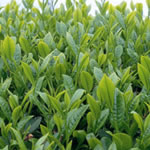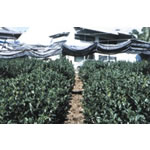Home > Teach me Tea Cha! > Cultivars > Shunmei
Main content starts here.
Shunmei
Shunmei: It is a good early-maturity cultivar with a germination period and a plucking period four to six days earlier than “Yabukita”


Notes on cultivation
The rooting of cuttings is good, and survival after planting is also good. The tree is strong in both young and adult trees, and its growth is strong.
The resistance to cold of "Shunmei" is strong. As for the disease resistance, anthracnose resistance is moderately strong, and ring spot disease resistance is strong, in fact, stronger than “Yabukita”. It is necessary to be careful as the occurrence of red blight can be seen in young trees. The tree is medium in shape, has a good horizontal spread, and the pruning of the young tree does not need to be kept low like “Yabukita”.
Processing characteristics
The sprouting and harvesting periods of “Shunmei” in the Kanaya area are four to six days earlier than “Yabukita”. The yield of the first flush tea is equal to or higher than that of “Yabukita” if no late frost damage occurs. As for the quality of the first flush tea, the shape is well tightened, and the color and luster is dark and good. The aroma is mild. The flavor is less astringent and has umami. Second and third flush teas have higher yields and better quality than “Yabukita”.
Notes on processing
Attention must be paid to the production, as it is dark green and sometimes blackish. Also, if the harvesting is delayed, the sprout is likely to harden. Please try to pick young shoots and conduct timely picking.
Dissemination and land suitability for cultivation
“Shunmei” attracted attention as an early-maturity cultivar of good quality immediately after breeding, but was overtaken by “Saemidori” which was registered two years later.
Although “Saemidori” is certainly a good cultivar, there are some problems with its cultivation traits, and suitable places for its cultivation are limited. Among the early-maturity cultivars, “Shunmei” has good cultivation characteristics, high yield, and is a cultivar that can be applied to a wide range. Since the germination period is a little later than “Saemidori”, there is less worry about frost damage, and even if damage occurs, it will recover faster. In terms of quality, the color and luster is a bit darker and thus not as good as “Saemidori”, but it is much better than “Yutakamidori” and other early-maturity cultivars which are the largest in cultivated areas.
